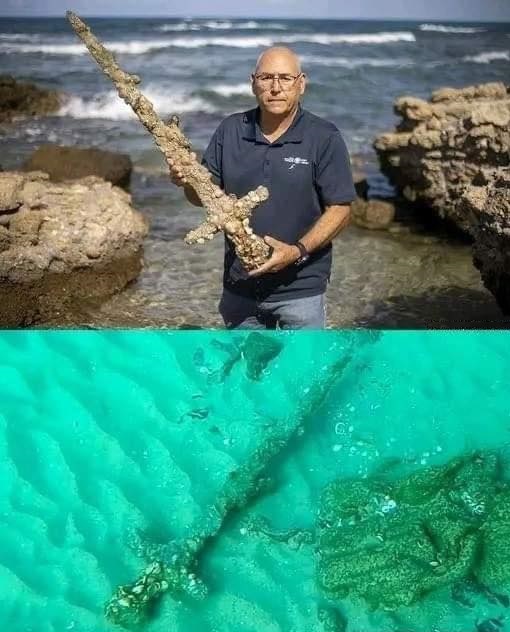Shlomi Katzin, an amateur diver from the coastal town of Atlit, Israel, experienced a moment that could only be described as extraordinary during what began as a routine dive in the Mediterranean Sea. Exploring the serene waters off the Carmel coast, Katzin’s attention was drawn to something unusual glinting beneath the layers of sand. Compelled to investigate further, he uncovered a remarkable artifact: a massive iron sword measuring over 39 inches in length, which experts would later confirm dates back to the era of the Crusades.

The surroundings of the discovery site told an even richer story. Alongside the sword were an assortment of ancient artifacts, including stone and metal anchors and fragments of pottery. These remnants painted a vivid and detailed picture of a historical epoch long gone. Katzin, recognizing the profound importance of what he had found, carefully recovered the sword and promptly reported his discovery to the Israel Antiquities Authority (IAA). His actions underscored a deep respect for the preservation of history and ensured that the artifact would be properly studied and conserved.
Expert Validation
Nir Distelfeld, an inspector for the Israel Antiquities Authority, was among the first experts to examine the sword. He confirmed its authenticity, remarking, “The sword, which has been preserved in excellent condition, is an exquisite and rare find. It clearly belonged to a Crusader knight.” Despite being encrusted with marine life after centuries beneath the sea, the iron blade’s exceptional craftsmanship was still evident, a testament to the skill of its makers and its historical significance.
Historical Significance of the Carmel Coast
Kobi Sharvit, the director of the IAA’s marine archaeology unit, provided deeper context about the site of the discovery. According to Sharvit, the Carmel coast has historically served as a haven for ships seeking refuge from storms, making it a hotspot for archaeological treasures. Over the years, numerous significant finds have been unearthed in this area, including anchors that date back to the Late Bronze Age, around 4,000 years ago. This particular discovery adds another layer to the region’s already rich archaeological narrative, offering new insights into the maritime history of the Crusader period.
The road to fully understanding and preserving the sword is now underway. Specialists at the Israel Antiquities Authority are meticulously cleaning and analyzing the artifact in their state-of-the-art laboratories. This process is crucial not only for removing centuries of marine encrustation but also for uncovering hidden details that may reveal more about its origin, use, and the person who once wielded it. Once these analyses are complete, the sword will be displayed for the public to admire, allowing people from around the world to connect with a tangible piece of Crusader history.
The Sword’s Broader Legacy
Shlomi Katzin’s chance discovery represents more than just the unearthing of a medieval weapon. It serves as a profound reminder of the wealth of history that lies hidden beneath the waves of Israel’s coastal waters. The 900-year-old sword is a bridge to a time of knights and Crusades, offering a glimpse into the lives and struggles of those who lived during a pivotal period in human history. It highlights the enduring importance of maritime archaeology and the stories that the sea can tell us about our past.
The Crusades were a series of religious and military campaigns that shaped the course of medieval history. The sword’s connection to this era provides historians and archaeologists with a tangible link to those tumultuous times, sparking curiosity and encouraging further exploration. As an artifact, it stands as a testament to the resilience of history and the enduring impact of the events it represents.
Encouraging the Public to Engage With History
Discoveries like this one also serve to inspire public interest in archaeology and the preservation of cultural heritage. The story of Shlomi Katzin’s dive is a reminder that significant historical finds can often occur when least expected, and it underscores the importance of protecting our underwater treasures. By ensuring that artifacts like this sword are preserved and studied, institutions like the Israel Antiquities Authority help foster a deeper appreciation for the richness of our collective history.
Furthermore, the sword’s discovery encourages amateur divers and enthusiasts to remain vigilant and respectful when exploring historically significant areas. Katzin’s swift action in reporting his find serves as a model for others who may come across similar artifacts, emphasizing the importance of collaboration between the public and professional archaeologists.
A Symbol of Human History
Artifacts like this Crusader sword remind us of the intricate tapestry of human history. From the hands of a medieval knight to the depths of the Mediterranean Sea, and now to a laboratory where it will be studied and eventually displayed, this sword’s journey mirrors the resilience and interconnectedness of humanity’s past. It is not merely an object; it is a symbol of an era, a culture, and a story that continues to captivate us centuries later.
Looking Ahead
As the Israel Antiquities Authority completes its work on the sword, its eventual public display will allow people from all walks of life to marvel at its historical significance. This artifact will undoubtedly inspire future generations to learn more about the Crusader period, maritime history, and the role of archaeology in uncovering the secrets of the past. The discovery also serves as a poignant reminder of the need to protect our world’s cultural and historical treasures, both on land and beneath the waves.
Shlomi Katzin’s unexpected find is a testament to the enduring power of history and the profound connections it can create. Through his curiosity and quick thinking, a piece of the past has been brought into the present, ready to educate and inspire for years to come.





